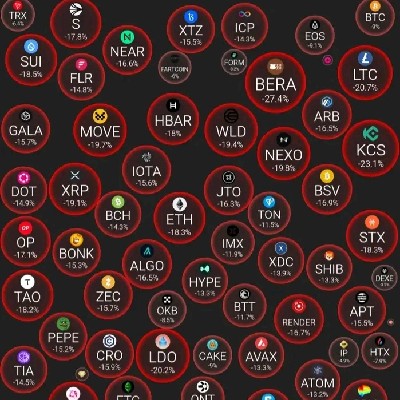How $HAEDAL Could Power the Next Wave of LSDfi Protocols on Sui
$HAEDAL In the ever-evolving world of DeFi, one sector has emerged as the most efficient and sustainable yield engine: Liquid Staking Derivatives Finance (LSDfi). While Ethereum’s stETH dominates the conversation, few are paying attention to what’s quietly brewing on the Sui blockchain—and $HAEDAL is leading the charge.
This isn’t just another liquid staking protocol. Haedal is building the base layer for LSDfi on Sui, with haSUI poised to become the collateral of choice across lending, yield strategies, and composable DeFi protocols.
From Liquid Staking to LSDfi: The New Frontier
Liquid staking is just the beginning. The next evolution is LSDfi—a set of protocols built on top of liquid staking tokens like haSUI, designed to maximize capital efficiency.
Haedal enables this through:
haSUI: A liquid, yield-bearing token representing staked SUI.
$HAEDAL: The incentive and governance token that powers the protocol’s economics.
Validator abstraction: Delegation to multiple validators ensures decentralization and security.
But here’s where it gets interesting: haSUI can now be used as programmable money in emerging DeFi strategies on Sui.
Why haSUI Is Perfect for LSDfi
haSUI is uniquely positioned for LSDfi because it combines high liquidity with stable yield generation. It is more than just a receipt token; it’s programmable money, allowing for composability across the Sui ecosystem.
What makes haSUI a key player in LSDfi:
Stable Yield Source: haSUI continues to earn staking rewards as it’s used in DeFi.
Liquid and Transferable: Unlike traditional staking, haSUI remains liquid and can be traded or swapped across decentralized exchanges (DEXs).
Composable: haSUI is easily integrated into other DeFi strategies, including lending, liquidity pooling, and vaults.
Backed by Real SUI: The underlying SUI backing haSUI ensures its value and security.
With these features, haSUI is ready to act as the foundation for advanced DeFi use cases, paving the way for the next wave of LSDfi on Sui.
LSDfi Use Cases Already in Motion
Here’s how haSUI could trigger a DeFi flywheel:
1. Collateral for Lending
Imagine a protocol like Sui-native Aave, where users borrow stablecoins by locking haSUI—earning staking yield while borrowing.
2. Liquidity Pooling & Farming
Pair haSUI with SUI, USDC, or $HAEDAL to farm extra yield—effectively triple-dipping: staking rewards, LP fees, and farming incentives.
3. LSD Vaults and Structured Products
Vaults that auto-compound haSUI strategies (like convex-curve on Ethereum) could launch, enabling smart users to farm with leverage.
4. Options and Perpetual Protocols
haSUI-backed derivatives could enable new financial primitives like options and leverage with built-in yield.
$HAEDAL: The Coordination Layer of LSDfi on Sui
While haSUI serves as the engine, $HAEDAL is the fuel that powers coordination, governance, and incentivization.
Key Roles for $HAEDAL in LSDfi:
Vault Boosting: Users stake $HAEDAL to boost haSUI vault returns.
Voting Rights: Token holders direct emissions, reward weight, validator sets.
Incentive Layer: Future LSDfi protocols can integrate $HAEDAL rewards to bootstrap their liquidity.
Think of $HAEDAL as Sui’s answer to Curve + Convex, controlling the flow of yield and liquidity across DeFi.
Why Smart Money Is Watching
If Ethereum’s LSDfi sector has a market cap in the billions, imagine Sui’s lighter, cheaper, and faster version—with $HAEDAL at its core.
VCs, DAOs, and whale wallets are quietly accumulating positions. While retail focuses on price, insiders are positioning for DeFi dominance. A few months from now, haSUI could be everywhere: vaults, lending, DEXs—and $HAEDAL will be what governs and rewards all that activity.
---
Final Thoughts: From Underdog to Infrastructure
$HAEDAL isn’t just a token—it’s a thesis. A bet on LSDfi becoming the default yield layer of Sui DeFi.
As more protocols integrate haSUI, and $HAEDAL begins directing rewards across ecosystems, those who understand the flywheel now will be the ones reaping exponential rewards later.
Understanding Haedal Liquid Staking👇👇👇
Unlocking Liquidity in the Proof-of-Stake Era
In the evolving world of blockchain and decentralized finance (DeFi), the need to balance liquidity and earning potential has led to the rise of liquid staking. Haedal, a next-generation liquid staking protocol, is revolutionizing the staking landscape by enabling users to earn staking rewards without locking up their assets. This seamless experience merges the benefits of traditional staking with the freedom of DeFi liquidity — a game-changer for SUI and WAL token holders.
What is Haedal Liquid Staking?
Haedal is a decentralized liquid staking protocol that allows users to stake their SUI or WAL tokens while maintaining full access to the value of their staked assets through derivative tokens. These derivative tokens, known as haTokens (e.g., haSUI and haWAL), represent a user’s staked assets and can be used across various DeFi platforms, enabling users to earn additional yield, trade, or provide liquidity.
Unlike traditional staking, where tokens are locked and inaccessible for a defined period, Haedal’s liquid staking model ensures capital efficiency by giving users the best of both worlds — staking rewards and asset utility.
How Does Haedal Liquid Staking Work?
The process of participating in Haedal’s liquid staking is streamlined into a few intuitive steps:
1. Deposit SUI or WAL Tokens
Users begin by depositing their SUI or WAL tokens into the Haedal staking smart contract. These deposits are then delegated to high-performance validators on their respective blockchains. Haedal carefully selects validators based on performance, uptime, decentralization criteria, and security to ensure optimal network participation and consistent reward generation.
2. Receive Liquid Staking Receipt Tokens (haTokens)
Upon staking, users receive a 1:1 amount of liquid staking tokens — known as haTokens. For example:
Staking SUI results in haSUI
Staking WAL results in haWAL
These haTokens act as proof of ownership and are yield-bearing assets. They continuously increase in value as the underlying staked assets earn rewards. Importantly, users maintain full custody over these tokens, allowing them to participate in other DeFi activities.
3. Earn Staking Rewards Automatically
Validator rewards, accrued through the network’s Proof-of-Stake (PoS) consensus mechanism, are automatically reflected in the increasing value of haTokens. This means the value of haSUI and haWAL gradually appreciates over time, representing the compounded rewards from the underlying SUI and WAL stakes.
Haedal manages the compounding process, redistributing rewards back into the system, allowing users to benefit from passive income without any active management.
4. Utilize haTokens Across DeFi
A core advantage of Haedal’s liquid staking system is the ability to use haTokens across various DeFi protocols:
Provide liquidity in decentralized exchanges (DEXs)
Earn yield through lending platforms
Trade freely with others
Use as collateral for loans
This opens up additional earning opportunities, turning staked assets into productive financial instruments within the broader DeFi ecosystem.
5. Redeem and Unstake Anytime
When users are ready to exit their position, they can redeem their haTokens for the original asset (plus rewards). Haedal offers multiple unstaking options:
Instant Liquidity Pools: For immediate withdrawals at a variable exchange rate.
Standard Unstaking Queue: Users can opt for a delayed withdrawal to receive the full amount (subject to network unbonding periods).
This flexibility ensures users retain control and freedom over their funds, even in a dynamic market.
What Makes Haedal Unique?
Haedal distinguishes itself through a combination of technical excellence, robust security, and deep integration with the DeFi ecosystem. Key features include:
1. Non-Custodial Design
Users maintain control over their assets at all times. Haedal’s smart contracts are transparent, decentralized, and auditable, reducing the risks associated with centralized staking providers.
2. Validator Optimization Engine
Haedal automatically selects high-performance validators to maximize rewards and ensure network stability. This improves yield efficiency without requiring users to manage validator relationships manually.
3. Interoperable haTokens
Haedal is focused on maximizing composability. haSUI and haWAL are ERC-20 compatible (or equivalent on their native chains) and are designed to be integrated seamlessly into other DeFi protocols, DEXs, and liquidity pools.
4. Reward Transparency and Real-Time Tracking
Users can monitor their staking rewards and haToken value in real time through the Haedal dashboard. This transparency builds trust and provides insight into the protocol's performance.
5. Advanced Security Framework
Security is at the core of Haedal’s infrastructure. The protocol undergoes rigorous audits, implements multisig treasury controls, and uses real-time monitoring to safeguard user funds and system integrity.
Why Choose Liquid Staking with Haedal?
Traditional staking mechanisms, while essential to blockchain security, are plagued by capital inefficiency. Locked tokens mean lost opportunities — especially in volatile or fast-moving DeFi markets. Haedal addresses these challenges directly by offering:
Increased Capital Efficiency: Put your staked assets to work in DeFi.
Continuous Yield Generation: Earn rewards passively without missing market opportunities.
Enhanced Liquidity: Trade or swap your haTokens any time.
DeFi Integration: Use haTokens for LPing, borrowing, or farming.
Community-Driven Governance: As Haedal evolves, $HAEDAL token holders will have governance rights, contributing to the development and direction of the platform.
The Future of $HAEDAL
The $HAEDAL token is more than just a utility token — it's a governance and incentive mechanism that aligns users, validators, and developers under a common vision. Future developments include:
Staking Incentives for $HAEDAL holders
DAO-based governance for protocol upgrades
Cross-chain liquid staking support
Expansion into new Layer-1 and Layer-2 ecosystems
Haedal aims to become the leading liquid staking solution not just for SUI and WAL, but for multiple blockchains, supporting a truly multi-chain staking future.
Final Thoughts
Haedal is pioneering a smarter way to stake in the PoS economy. By combining the reliability of traditional staking with the freedom and flexibility of DeFi, Haedal empowers users to earn passive income without compromising access to their assets. With robust security, growing ecosystem integration, and forward-looking innovation, Haedal is well-positioned to become a cornerstone in the future of decentralized finance.
$HAEDAL
🇺🇸 Current Status of the U.S. Strategic Bitcoin Reserve1
As of May 4, 2025, the U.S. Strategic Bitcoin Reserve remains a focal point in the nation's evolving cryptocurrency strategy.
Establishment: On March 6, 2025, President Donald Trump signed an executive order to create the Strategic Bitcoin Reserve and the U.S. Digital Asset Stockpile. The reserve is primarily funded by Bitcoin seized through federal asset forfeiture, with holdings estimated at approximately 198,000 BTC, making the U.S. the largest known state holder of $BTC .
Policy Framework: The executive order mandates that the Bitcoin in the reserve shall not be sold, positioning it as a long-term strategic asset. The Treasury and Commerce Departments are authorized to develop budget-neutral strategies for acquiring additional Bitcoin, ensuring no incremental costs to taxpayers.
Legislative Developments: Senator Cynthia Lummis has introduced the BITCOIN Act of 2025 (S.954), aiming to codify the reserve into law and establish a decentralized network of secure facilities across the United States for Bitcoin storage. The bill also allows states to voluntarily store their Bitcoin holdings in segregated accounts within the federal reserve system.
📈 Market Impact and Reactions
Market Response: Initially, the establishment of the reserve had a muted effect on Bitcoin's price, which hovered between $77,000 and $87,000 throughout April. However, by early May, Bitcoin rebounded to approximately $95,600, erasing some earlier losses.
Analyst Perspectives: Some analysts view the reserve as a long-term bullish signal, suggesting it could drive institutional adoption and higher Bitcoin prices over time.
State-Level Initiatives: States like Arizona are leading efforts to establish their own Bitcoin reserves, with proposed legislation to allocate a portion of state funds to Bitcoin holdings.
🧭 Strategic Implications
The establishment of the Strategic Bitcoin Reserve marks a significant shift in U.S. economic policy, integrating digital assets into national financial strategy. This move could enhance the credibility of cryptocurrencies and encourage other nations to consider similar reserves. The CIA has also recognized Bitcoin as a strategic tool, utilizing it to track financial activities of U.S. adversaries and disrupt their networks.
market strategy!
**"Supply and Demand Zone" can be considered a good STRATEGY, and Insha Allah, it will benefit you. Open your Trading
View now—don't wait until later. Since you've seen this post now, act now. Don’t say ‘later’—I'm also working on drafting a chart on $Dark.
Find a project that’s generating high 24-hour volume, then draw your Support and Resistance zones. Just draw them and leave them as they are. For example, like this: if you zoom into the chart, you'll see how the token moves. When it reaches the Supply Zone, you can exit the market. Then, continue to monitor it—when it returns to the Demand Zone, you place an order again. Keep rotating like that.
Many traders don’t draw charts on their screens properly, especially if they’re not scalpers. Look at how the chart for $House moved yesterday: it touched the Demand Area at $55 million, reversed to $72 million, and after hitting $72 million, it corrected down to $67 million before reversing again. Go check your TradingView and see the current state of the $Dark token.



 Precio más bajo
Precio más bajo Precio más alto
Precio más alto 



























.png)











